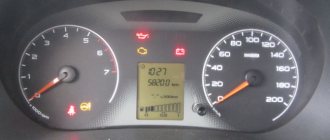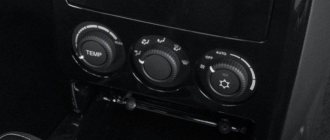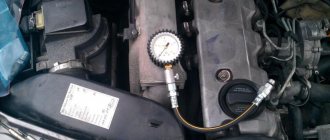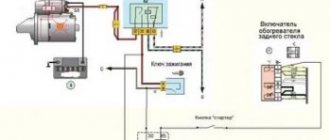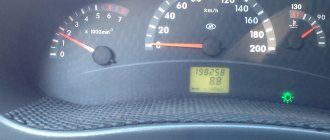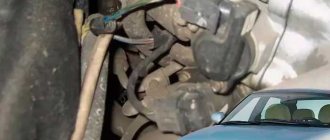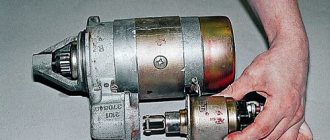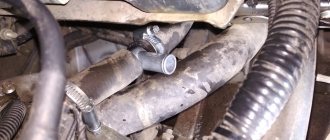The main reasons for insufficient heating of the internal combustion engine
Thermostat stuck open
A common cause of insufficient engine temperature is a stuck thermostat.
One of the common causes of this problem is a stuck thermostat in the slightly open position. This may occur due to a foreign object getting under the valve: a piece of sealant, scale, scale. Also, the thermostat becomes unusable after a certain period of use. As a result, the coolant begins to circulate in a large circle rather than in a small one. The solution to this situation is to replace the jammed part. The next reason for the engine not warming up to operating temperature is the time of year.
Warming the engine in winter
The most unpleasant cause of low engine temperature is damage to the cylinder block gasket.
In winter, especially in severe frosts, the internal combustion engine may have insufficient temperature. To eliminate the problem, it is necessary to perform additional insulation of the engine. The answer to the question is sometimes hidden in the discrepancy between the brand of coolant and the manufacturer’s recommendations. If this is the reason, then it is enough to change the fluid to the desired one. The most serious reason why the engine temperature does not rise above 80 degrees is a damaged cylinder head gasket. Because of this problem, exhaust gases begin to enter the cooling system, which leads to a violation of the temperature regime. Causes of gasket damage include engine overheating or a thermostat that is stuck in the closed position.
Basic faults
If the sensor is working correctly, the needle moves smoothly, but if there is a problem, the movements will be sharp and jerky. With such work, not only can it be impossible to correctly assess the temperature position, but it can also cause damage to the engine and the entire system. Breakdowns can be different and happen in several places at once, but most often motorists encounter the following reasons:
- Thermostat failure.
- Malfunctions in the operation of the coolant temperature sensor.
- Malfunction of the indicator itself and the sensor needle.
- Short circuit in the electrical board.
These causes are arranged according to frequency of occurrence, so we advise you to make the same diagnosis. If it is possible to turn to a specialist for help, this will significantly reduce the time it takes to find and eliminate the cause.
Thermostat failure
The problem with the thermostat is the most common, and all because of the poor protection of this part. The fact is that it can break even on a new car. Some people talk about randomness, and others about the conditions of use. One way or another, it is worth understanding how this system works and how to check its serviceability.
Often such breakdowns occur at low temperatures, but can and will also occur in the opposite conditions (heat waves). When the car starts and the engine warms up, the sensor needle immediately jumps to the correct value, and then the thermostat opens. The coolant begins its movement through all components through the pipes, however, if the thermostat is broken, it shorts out and blocks further passage for the liquid. There are cases of complete closure of the thermostat valve, and there are cases of partial closure, but in both cases, prolonged operation of the engine will lead to overheating and the engine temperature sensor will jump.
To independently diagnose, you should check the thermal state of the supply pipes. In cases where the thermostat is stuck, the lower pipe will be colder than the top. This will prevent the coolant from making a large circle and the engine from starting to operate normally.
Coolant temperature sensor
The next most common breakdown is the coolant temperature sensor. Sometimes it may happen that a contact in it comes loose and data will not flow or will come with breaks in the circuit. Because of this, the needle will twitch, because for it the indicators jump sharply from the working value to zero. There is also a possibility that the sensor itself is broken and it simply cannot record data properly.
When each sensor is detected, you need to make sure that it is intact, as well as that the contacts are properly connected. To fix it, two people will be needed: one moves the contact, and the other monitors the arrow readings. If the arrow reacts to actions and starts jumping, then the problem is with this sensor.
Arrow and temperature sensor
In cases where the thermostat and the thermal sensor connection contact are in order, it is worth paying attention to the sensor indicator itself, there may be malfunctions in the integrity of these parts. In order to identify a breakdown, you need to have certain knowledge about the resistance and structure of this electrical mechanism
Because perhaps it is the poor condition of the sensor that makes the needle jump like crazy.
This knowledge can be studied independently on the Internet or in specialized books, where all operations and indicators are carefully described. But the best outcome, of course, would be to contact a specialist who already knows about all the intricacies of the sensor design.
Electrical board of instrument panel
If everything works well, but the temperature sensor still jumps, then all that remains is to disassemble the instrument panel and check the electrical board. If the soldering is broken or done poorly, it will lead to problems like this. If you plan to fix this problem yourself, we recommend taking a soldering iron with a thin rod and low power so as not to damage the board and adjacent parts.
It is also worth paying special attention to the output mass and resistors. And if you can’t do this kind of work yourself, then contact a specialist who will do it quickly and without errors.
Why doesn't the engine temperature gauge rise?
Checking the coolant level
The first thing to do if the engine temperature is abnormal is to check the coolant level.
Sometimes a situation may arise when the engine temperature is quite normal, but the arrow does not point to the correct parameter. This may be due to a lack of coolant. To prevent the engine from “boiling” during the trip, it is necessary to check its level before starting to drive. If a deficiency is detected, top up to the optimal level. Incorrect readings may also be displayed if the temperature sensor is faulty . It often fails:
- by service life;
- after an accident or strong shaking;
- due to a wiring problem.
As can be seen from the above, the answers to the question of why the engine does not warm up to operating temperature may be different. They are often associated with breakdowns of car parts. If there is no special knowledge, the driver should contact a car service center who can quickly determine the cause and eliminate it.
Source
How to check the coolant temperature sensor?
There are two ways to check the functionality of the DTOZh: by dismantling it or directly on the car. Let's take a closer look at them.
Checking the removed sensor
First, the coolant temperature sensor must be removed. To do this, you only need a wrench of the appropriate size. Then for diagnosis you will need water, a boiler or electric kettle, an electronic multimeter that can measure resistance and a thermometer.
We pour water into the container we are using and place the sensor and thermometer in it and heat it up. After this, we measure the resistance at intervals of every 5 °C. The output will be a table with data that needs to be compared with those indicated in the technical documentation of your car. You can also find a similar table on the Internet.
This method, of course, is not without errors, but they are not critical and depend entirely on the diagnostic conditions, as well as on the characteristics of the sensor itself.
You can check the performance of the DTOZH without a thermometer. To do this, the sensor is immersed in boiling water, and then its resistance is measured using a multimeter. If the part is in good condition, then the resistance value will be as close as possible to what is indicated in the table. Small discrepancies in this case are acceptable.
CAUSES OF ENGINE OVERHEATING
Overheating can be caused by many reasons, all of them are related to a malfunction of the cooling system, or the quality of the coolant, as well as contamination of the cooling system jacket, which impairs the fluid throughput. It is important to use high-quality spare parts, otherwise the reasons below will happen suddenly. Let's look at each of the reasons.
LOW COOLANT LEVEL
The most common problem is a lack of coolant in the system. Coolant, in the form of antifreeze or antifreeze, constantly circulates through the system, removing heat from heated engine parts. If the coolant level is insufficient, the heat will not be removed sufficiently, which means an increase in temperature will be inevitable.
If it is not possible to add coolant, then turn on the heater to reduce the likelihood of overheating. As a last resort, add regular or distilled water, after which the cooling system must be flushed and then filled with fresh antifreeze. At temperatures above 90 degrees, you should immediately stop the car, turn off the ignition, and allow the engine to cool.
ELECTRIC COOLING FAN FAILED
The electric fan forces cool air onto the radiator, which is especially necessary when driving at low speeds when there is insufficient air flow. The fan can be installed either in front or behind the radiator. If the temperature arrow starts to rise, stop the car and check the fan for serviceability. Reasons for fan failure:
- electric motor failed
- connector oxidized
- fan relay burnt out
- The internal combustion engine temperature sensor has failed.
To check the fan, remove the connectors from it and connect the wires directly to the battery, which will allow you to determine the cause of the failure.
THERMOSTAT FAULT
The thermostat is one of the main elements of the cooling system. The cooling system has two circuits: small and large. A small circuit means that fluid circulates only through the engine. In a large circuit, fluid circulates throughout the system. The thermostat helps you quickly reach and maintain operating temperature. Thanks to the sensitive element, which opens the valve at 90 degrees, the liquid enters a large circle, and vice versa. The thermostat is considered faulty in two cases:
- operating temperature of the coolant is not reached
- the power unit tends to overheat.
5) Dirty radiator
If your car has driven more than 80 thousand km, then most likely the cooling radiator is very dirty, which can also cause the engine to overheat.
In order to avoid this, it is necessary to flush the radiator every year. It is advisable that, along with cleaning the radiator, the coolant itself is changed. Despite the fact that the manufacturer itself recommends changing antifreeze every 3 years, we, for our part, strongly recommend changing this coolant every year.
In conclusion, dear readers, we would like to once again remind all car enthusiasts that in addition to regularly checking the entire cooling system (especially before a long trip), it is necessary to periodically conduct a complete diagnostic of the operation of all the most important systems of the car. Don't forget to regularly check the oil level in your car engine. Remember that by maintaining the engine oil level at optimal values, you reduce the load on the engine itself and thereby prevent unnecessary overheating (heating) of the engine in advance.
The lower the load on the engine, the longer the service life of the vehicle's power unit. Good luck to you friends!
An internal combustion engine is a kind of furnace in which, during the combustion of working mixtures, the temperature in the cylinders reaches 2000 °C and higher. At such temperatures, the metal begins to lose its strength characteristics, which can lead to problems associated with the operation of the engine, or, in general, send it to the cemetery. To avoid such consequences, cars are equipped with a cooling system that limits the temperature limits of the engine, thereby ensuring the correct conditions for its operation. A car engine is a metal mechanism, which, unfortunately, is not perfect. And various types of failures in its operation are still present. The most famous are when the engine gets very hot, or, conversely, takes a long time to warm up. What causes this?
CAUSES OF LOW ENGINE TEMPERATURE
Low engine temperature may occur in the following cases:
- use of an inappropriate thermostat (opening temperature too early)
- high performance of cooling fans, or their forced operation from the moment the engine starts
- thermostat malfunction
- non-compliance with the proportion of mixing antifreeze with water.
If you purchase antifreeze concentrate, it must be diluted with distilled water. If in your region the temperature has dropped to a maximum of -30°, then purchase antifreeze marked “-80” and dilute it 1:1 with water. In this case, the resulting liquid will heat and cool in time, and will not lose its lubricating properties, which is extremely necessary for the pump.
Source
How to find out why your car is overheating.
Engine overheating is the worst thing that can happen to us on the road. Due to high temperatures, the car engine may fail and you will then have to go to a technical center for expensive repairs. As a rule, such overheating of the car (of course the engine) mainly happens when you get into a traffic jam. At this moment, any driver (or almost any) prays that the flow of traffic from cars does not stop and at least continues to move a little. The point is this: while driving, your engine receives additional air flow and thereby is constantly cooled, which means it does not overheat. So what are the main reasons for engine overheating and how can you and I avoid it?
It is equally important to know: The most expensive breakdowns in a car
There are several main reasons why the engine temperature begins to rise (creep to the top) and, if the car is not turned off, it will overheat.
The engine does not reach operating temperature
You can monitor the temperature readings of the power unit directly from inside the car. The dashboard of all modern cars has a small information field, usually round or semicircular in shape, showing the driver the coolant temperature readings. This is the device that gives an idea of the temperature conditions in which the engine is operating at a given time.
If the temperature gauge does not reach 90 degrees during a long trip, you should seriously think about finding the cause of the deviation from the normal operation of the power unit. It is not recommended to delay its diagnosis, because prolonged operation of the motor in this mode will lead to wear of its internal components.
The fact is that the electronic control unit, which is popularly called the “brains” of the car, recognizes an engine that has not reached the nominal temperature as cold, and therefore the fuel system injects an over-enriched mixture.
Working in this mode leads to heavy carbon deposits on the spark plugs and, accordingly, on the internal elements of the engine, which in the future will lead to the need for a major engine overhaul.
Reasons why the motor does not heat up to 90 degrees
If you begin to notice that during a trip the power unit does not heat up to the required temperature, you should check the functionality of the elements of the engine cooling system and find out why the engine temperature does not rise. Most often, the internal combustion engine does not reach the required temperature for several reasons.
The pipes are not tightened sufficiently, resulting in air leaks. In this case, minor leaks of coolant may be noticeable. To eliminate all these flaws, you need to check the tightness of the connecting tubes and how tightly the clamps are tightened on them, which, if necessary, should be tightened tighter.
The thermostat has failed - this element directs the flow of coolant circulating through the system: at first, when the engine warms up, it is closed and releases antifreeze or antifreeze only in a small circle; when the engine operating temperature approaches 80-90 degrees, the thermostat begins to open, releasing coolant into a large circle. When a thermostat fails, it means that it is stuck in a certain position that does not allow the power unit to reach normal temperature conditions. Replacing the thermostat will help get rid of this problem.
The coolant temperature sensor (abbreviated as DTOZH) is not working correctly - this is a rather complex thermoelement, thanks to which the coolant temperature readings are displayed on the information block on the car’s instrument panel. Thus, due to the incorrectness of the readings transmitted by the sensor to the dashboard, one may get the impression that the engine does not heat up to the required temperature, but in fact it operates in the correct temperature regime.
In order for the information transmitted by the sensor to correspond to reality, it is worth replacing it with a new one.
Car owners often encounter a problem where the engine does not heat up to operating temperature. Usually they do not pay attention to it right away, since not everyone knows why low engine temperature is dangerous. For normal operation, 100 degrees is required.
The question is why the engine does not heat up well and becomes hot when cold weather sets in, when it is not comfortable to be inside the car due to the low temperature. In addition, consumption increases significantly, the engine wears out faster, the car drives worse, and the level of toxic substances in the exhaust gases increases.
How does the engine warm up?
Each serviceable unit has a different warm-up time. It is influenced by:
- degree of forcing;
- engine type: diesel or gasoline;
- cooling system condition;
- stove operation;
- quality of antifreeze or antifreeze;
- outside air temperature;
- type and viscosity of engine oil.
The characteristics of the oil are rarely taken into account, but experts believe that this is necessary. Various friction reducing additives and the base stock, synthetic or semi-synthetic, affect the performance in the range of 5–7 degrees. Thus, the engine will heat up faster with thinner synthetic oil.
The engine temperature gauge does not rise often due to a malfunction of the thermostat.
It is with this unit that the system check always begins if the engine takes a long time to warm up to operating temperature.
Principle of operation
Coolant enters the radiator through the thermostat. This is a large circle of fluid circulation. The thermostat usually opens at a temperature of 100 degrees Celsius. If the temperature has not reached this limit, then the liquid moves in a small circle. A thermostat malfunction is manifested by improper opening of the valves.
When the thermostat is closed, the engine overheats, and a constantly open one leads to low temperatures, since the liquid will only flow in a large circle.
Due to irregular changes of antifreeze or antifreeze, use of running water or mixing of coolants, various deposits in the form of scale may accumulate in the system. In this case, the thermostat will inevitably jam in one of its positions.
Checking the Thermostat
To diagnose the malfunction, you should contact a service specialist. However, you can check the thermostat yourself. The cold engine is allowed to idle for approximately 10 minutes. After this, you need to check the radiator pipes. If the thermostat is functioning properly, the hoses will not become hot. The temperature rises only at the moment when the coolant begins to circulate in a large circle.
The coolant enters the large circle only after reaching operating temperature. If the pipes begin to heat up before the specified point, you should immediately contact a technician for further diagnosis and troubleshooting. There are also more professional diagnostic methods using special sensors. Such a check can be carried out at a service station.
If the device does not open and close completely, partial overheating may occur or the temperature will rise, but very slowly. Also, the wedge can be observed only periodically.
Any specified defect requires careful examination and repair. If you do not have the necessary skills and minimal knowledge about the internal structure of a car, you should contact qualified car service specialists.
To remove the thermostat, you must first get rid of the liquid in the system. It is important to wait until the entire system has cooled down before replacing the part. Removing the thermostat is quite simple; to do this, just unscrew the three bolts located on the cover and remove it together with the thermostat.
Taking into account all the design features of this model, it can be replaced with an identical or suitable analogue. Well-known brands produce units that can be interchanged, so there are no difficulties with selection. In any case, all manipulations must be carried out by a person who knows exactly what needs to be done, takes into account the make, year of manufacture, and mileage of the car.
It is very important to consider that the cost of this part is quite low, so it would be more appropriate to replace it than to repair it. Thus, you can get rid of problems with low engine temperature for the entire winter season.
Since when replacing the thermostat you will have to drain the fluid, it is worth checking the engine for performance before the start of the winter season. Many car owners pour antifreeze into the system and then face the need to replace the unit, therefore paying twice for the coolant.
Selecting and purchasing a thermostat for Kalina
Here I will not discuss what is better to buy and which thermostat to choose. Given the disgusting quality of most spare parts in stores, I do not consider it necessary to waste time on dubious tests and comparisons of parts from different manufacturers. I’ll just say one thing: I chose a factory-made thermoelement, that is, the element itself, and not the thermostat assembled with the housing.
If you do not have any problems with the body of this part, the thread for the sensor and thermoelement are in place, then you should not overpay 500 rubles on top. Feel free to buy an element that costs about 500 rubles for Kalina - the price of the factory one. When replacing it, there are much fewer problems with it; you only need a hexagon and a pair of heads with a knob for unscrewing the clamp screws.
As for the result of the work done, as expected, now there are no problems with the cooling system. The engine began to heat up much faster, and the operating temperature remains stable at 90 °C, and the on-board computer shows exactly these numbers.
As for the operation of the heater, it goes without saying that the higher the coolant temperature, the hotter it will be inside the car. Now it has become even warmer in my Kalina, which is what was required from this repair.
During the operation of the car, its owner has to deal with various malfunctions. As a rule, breakdowns that are somehow related to the operation of the power unit are of particular concern.
Even for beginners, it is not news that the car’s engine must warm up to its normal operating temperature, which is 90 degrees. This temperature regime is optimal.
What can be dangerous about a cold engine?
If you notice that the engine has not warmed up to operating temperature and it cannot rise, then you should start immediately troubleshooting, as the consequences can lead to serious expenses for repairs.
The electronic control unit installed on modern cars recognizes an unheated engine as a cold one. If it cannot warm up and the engine temperature does not rise, then an over-enriched mixture is supplied.
When the system has to operate in this mode, the spark plugs fail due to the appearance of carbon deposits on them and on the internal elements. Thus, you can significantly reduce the service life and face major repairs, which cost a lot of money.
If the engine does not warm up to operating temperature, you should immediately contact a car service to diagnose the problem so that similar malfunctions do not occur in the future.
Last tip
If you still look for the reason for what is happening to your engine - no, because of reluctance or lack of ability - look for smart specialists! There is no point in going to dealerships. The specialists who work there will not help you due to the fact that they are not trained in more than maintenance and pre-sale preparation.
Subscribe to topic
Notification by e-mail about replies to a topic during your absence from the forum.
Subscribe to this forum
Notification by e-mail about new topics on the forum during your absence from the forum.
Download/Print theme
Download the theme in various formats or view a printable version of the theme.
Other reasons
A malfunctioning thermostat may not be the only reason why the engine does not reach operating temperature.
If the pipes were not tightened well during the previous repair, the car owner is faced with air leaks. Coolant begins to leak. If this is the problem, then you should tighten the clamps for a tighter fit of the tubes and add fluid to the required level in the expansion tank.
In this case, the car owner will see a low temperature on the dashboard, which is insufficient for operation. In fact, the engine will overheat and may even boil.
A faulty temperature sensor can cause the engine to feel like it takes a long time to warm up or may not heat up at all. In this case, the engine works properly. The sensor transmits temperature status data to the dashboard. If it does not work correctly, then the readings will be incorrect. Replacing this part will bring all indicators back to normal.
The problem with the sensor is quite serious on modern cars equipped with electronics. Here again you will have to deal with supplying an over-enriched mixture and replacing many other parts.
Any problem that arises must be resolved with the help of a competent specialist. If you do not have the necessary knowledge and skills, you should contact a car service center. Experienced technicians will help eliminate the problem and prevent its occurrence in the future.
Quite common on gasoline and diesel cars. At the same time, many car owners do not pay due attention or do not notice this malfunction at all, especially in the warm season. The reason is simple - drivers are more afraid of overheating, but not everyone knows about the consequences of driving on a cold or insufficiently warmed up engine. So it turns out that if a gasoline or diesel engine does not reach operating temperature, the arrow of the temperature indicator on the dashboard does not reach the desired value on the scale, you can still drive. However, it should be taken into account that engine wear increases, the fuel appetite of the unit increases, the exhaust becomes toxic, the engine “pulls” worse, etc.
Typically, problems that cause the engine temperature not to rise become relevant with the onset of cold weather. The main sign of a problem is deterioration in the operation of the stove. In other words, the operating comfort of the vehicle decreases due to the low temperature in the cabin, which forces the driver to take action. Next we will talk about what to do if the engine operating temperature is low, the engine takes a long time to warm up to operating temperature, etc.
When the engine takes a long time to warm up
In winter, with the onset of frost, car owners have one experience replaced by another, and the latter is much more troublesome than the usual overheating of the engine. When it’s -20 -30 °C in the morning and the engine takes a long time to warm up, you can’t help but remember the beautiful, warm days. Well, it’s okay that the engine warms up a little, the main thing is that the fingers straighten! But the heat is still far away, and problems with the engine are already happening. In winter, there are three reasons why a diesel engine heats up slowly:
- The thermostat is made;
- An air lock has appeared in the coolant system;
- The motor is not insulated enough.
Checking the thermostat
Designed to be sensitive to changes in temperature, regardless of changes in pressure in the coolant system, the service thermostat will limit the circulation of antifreeze to a small circuit through the cooling jacket of the block and cylinder head. As the temperature difference between the environment and the engine increases, the thermostat smoothly opens the coolant supply from the main radiator to the engine. This is exactly what happens in the opposite case. Thanks to this, the temperature limits of engine operation are maintained and limited, and the vehicle interior is heated.
Let's sum it up
In this article, we examined one of the most common reasons why the engine does not warm up, may cool down while driving, the engine temperature does not rise above 70 degrees, etc. Let us add that in the latter case, on a car with an unknown history, it often turns out that the previous owner had previously installed a too “cold” thermostat. In parallel with this, other malfunctions of the cooling system may occur, as a result of which the internal combustion engine does not heat up.
It should also be noted that repairing the device is impractical given its relatively low cost. For this reason, instead of descaling the thermostat and trying to eliminate its jamming, it is better to immediately install a new element on the machine.
Source
